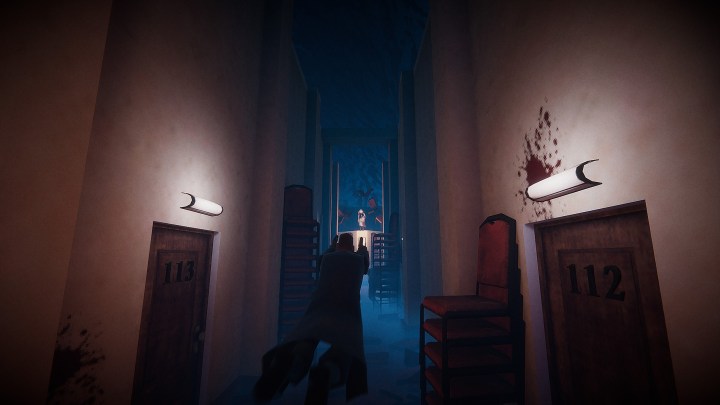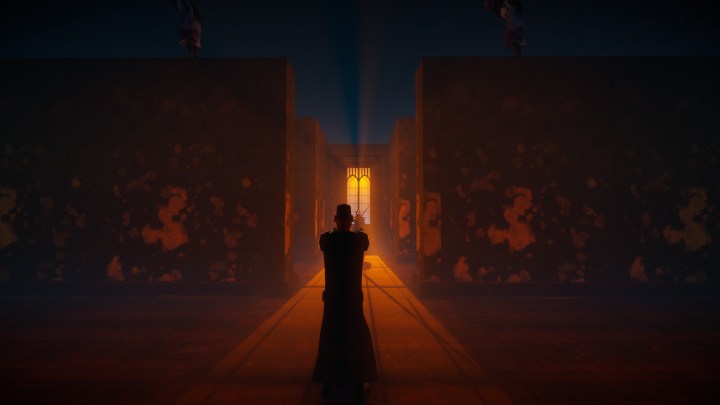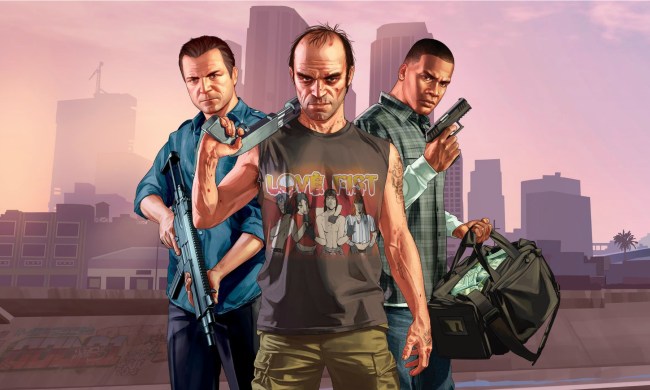Ever since it was first announced, I’ve been completely entranced by El Paso, Elsewhere. Developed by Strange Scaffold, the indie shooter looks like the developers of Max Payne were asked to create a Constatine game, and then someone made a PS1 demake of the result. It’s a wild and weird action game that sees its trenchcoat-wearing hero gunning down monsters during slow-motion dives. It’s a premise that sells itself once you watch a trailer of it.
Going into my first hands-on demo with it at this year’s Game Developers Conference, I wanted to know more. I figured I’d know how satisfying its bullet-time action felt within a few minutes, but I hoped to find some extra depth in its intriguing neo-noir story. As I quickly learned from Strange Scaffold studio head Xalavier Nelson Jr., El Paso, Elsewhere is much more than a small-scale Max Payne homage. It’s a richly detailed meditation on race, addiction, and more – all wrapped up in a stylish gameplay system that feels as fun as it looks.
Max Payne’s spiritual successor
El Paso, Elsewhere is a third-person shooter that wears its Max Payne influences on its sleeve. From its dark noir monologues to its commitment to black trench coats, there’s no mistaking what the foundation is built on. Though that’s the inspiration, El Paso entirely deviates from the PS2 classic when it comes to its story and structure. Its hero is James Savage, a pill-addicted gunman who’s on a mission to save the world from his vampire ex-girlfriend. That takes him to a small motel that’s somehow defied reality and grown over 46 stories tall.
The levels I played were built like small mazes, filled with vampires, werewolves, and other creatures to blast away. While the slow-motion gunplay most explicitly welcomes its Max Payne comparisons, it almost feels a bit more like Hotline Miami reimagined in 3D. Survival can be incredibly tough, as I had to react quickly in tight hallways or bathrooms. I died a million deaths during my playthrough, with each one teaching me to better prepare for what was around each corner and conserve my limited slow-mo meter carefully.

When I finally do clear a wave of enemies, it’s like I’ve just finished a gracefully morbid dance. Each slow-mo dive earns its own “oohs” and “aahs” as I sail over a werewolf and blast them with a shotgun or dive away from a vampire’s attack while leaving a trail of uzi fire in my wake. What worked so well for Max Payne works just as well here in a hypnotizingly lo-fi art style.
While the action is as strong as I expected, paying homage to classic shooters while maintaining a wholly unique texture, I’m drawn further the more Nelson Jr makes it clear that there’s substance to the style. For instance, Savage heals himself by popping pills. That isn’t just an empty nod to Max Payne’s healing system; the story will actually grapple with Savage’s very real addiction problem.
Even its hero’s name isn’t just a funny riff on “Max Payne.” Nelson Jr points out that it’s no coincidence that El Paso’s Black hero has “Savage” as a last name. It’s a loaded word that’s historically been used to dehumanize Black people, and the neo-noir story will grapple with that too. None of the small details are accidents. They recontextualize a handful of silly video game decisions, transforming them into powerful narrative tools. The medium is the message.

At the end of my demo, I walk away with exactly what I hoped to gain going into it. Strange Scaffold isn’t delivering your average indie action game built around a core, gameplay-forward hook. There’s a rich neo-noir underneath all the slow-mo dives, wrapped up in 46 stories of hell-raising, supernatural melodrama. I don’t need to know another detail; I’m ready to lock and load.
El Paso, Elsewhere is scheduled to launch this fall on PC, Xbox One, and Xbox Series X/S.



